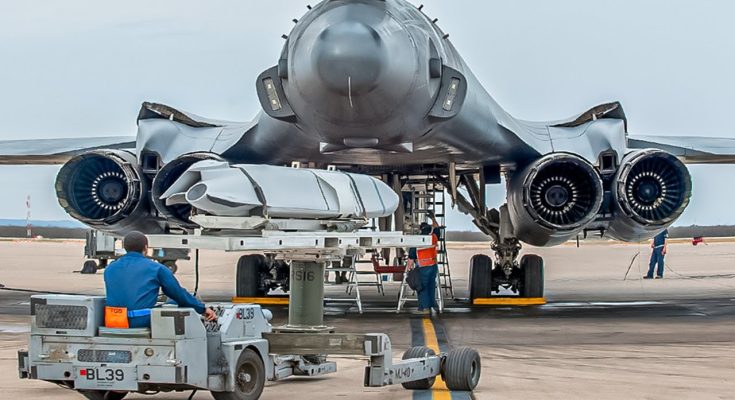The U.S. Air Force is Loading the B-1 Lancer with Tons of Missiles
On the edge of the runway at a forward-operating base, the unmistakable silhouette of the B-1B Lancer looms large. Nicknamed “The Bone” (from B-One), this supersonic strategic bomber is one of the most fearsome tools in the U.S. Air Force’s arsenal — and it’s being loaded to the max with tons of precision-guided missiles in preparation for a high-intensity strike mission.
The B-1B Lancer, operated by Air Force Global Strike Command, is a long-range, heavy bomber with incredible payload capacity and speed. What sets it apart is its ability to carry a massive weapons load — up to 75,000 pounds — more than any other U.S. bomber. While it was originally built for nuclear deterrence, the B-1 was converted in the 1990s to carry only conventional weapons, and today it’s capable of delivering an unmatched variety of precision-guided munitions.
Massive Payload, Global Reach
In this operation, ground crews are loading the Lancer with a full complement of Joint Air-to-Surface Standoff Missiles (JASSMs), GBU-31 JDAMs, and AGM-158B JASSM-ER missiles — long-range, low-observable cruise missiles designed to destroy high-value, well-defended targets from hundreds of miles away.
Inside the aircraft’s three internal weapons bays, rotary launchers are prepared to carry multiple standoff weapons. On the tarmac, weapons specialists from the USAF’s munitions teams carefully handle and secure each missile using hydraulic lifts and precision tools. The process is methodical and highly choreographed — every connection is checked, and every payload is verified through the aircraft’s mission systems.
“Loading the B-1 is an operation of precision and power,” says a Senior Munitions Technician. “This aircraft can deliver an overwhelming strike with pinpoint accuracy — and that’s exactly what we’re preparing for.”
Versatility and Speed
The B-1’s swing-wing design allows it to fly at both high and low altitudes, with a top speed of Mach 1.2. It’s capable of striking deep into enemy territory while remaining agile and hard to detect. During combat operations, the B-1 typically flies in from standoff distances, launching its cruise missiles from beyond the reach of most enemy defenses. This gives commanders a strategic advantage — rapid response without the need for forward basing or air superiority already in place.
The Lancer’s ability to carry dozens of long-range missiles makes it ideal for saturation strikes — launching large volleys of precision weapons that overwhelm enemy radar and defense systems. The AGM-158B JASSM-ER, for example, can hit targets over 500 nautical miles away with stealthy, autonomous precision.
Combat-Ready and Forward-Deployed
The B-1B is a frequent participant in Bomber Task Force missions across Europe, the Indo-Pacific, and the Middle East. These deployments not only deter adversaries but also test the bomber’s ability to operate in dispersed, austere environments. Loading missiles at remote bases or allied airfields ensures that the B-1 can deliver combat power anywhere, anytime.
As the last missile is secured and the crew runs final system checks, the B-1 Lancer prepares for takeoff — a flying arsenal ready to bring overwhelming firepower wherever it’s needed.



